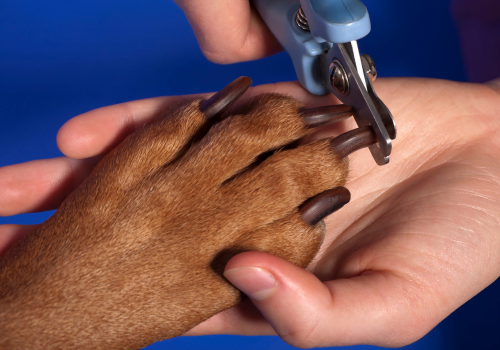Estimated reading time: 4 minutes
It’s natural to be concerned when you notice changes in your dog’s nails, such one or more of them turning black. There can be various reasons for this change, and understanding the causes can help you take appropriate action to keep your furry friend healthy.
In this article, we will discuss 10 possible reasons for your dog’s nails turning black and provide helpful information on each cause.
Natural Pigmentation
For some dogs, having black nails is simply a result of their genetics. Certain breeds (such as Black Labs, Rottweilers, Doberman Pinschers, and German Shepherds) have darker nails as a normal characteristic. The color of your dog’s nails can also be influenced by their coat color and individual genetic makeup.
If your dog’s nails have consistently been black or dark-colored, this is likely the reason.
Fungal Infections
Fungal infections, like onychomycosis, can cause a dog’s nails to turn black. Along with the color change, the nails may become brittle, thick, or emit an unpleasant smell.
If you think a fungal infection might be the cause, visit your veterinarian for a diagnosis and the right treatment. The vet will likely prescribe antifungal medications, either in oral or topical form, depending on the severity of the infection.
Bacterial Infections
Bacterial infections, such as pseudomonas, can also result in black nails in dogs. Symptoms may include inflammation, pain, and discharge, in addition to the nail discoloration.
If you notice these symptoms, take your dog to the vet for a proper diagnosis and treatment plan, which may involve antibiotics and potentially trimming or removing the affected nail.
Trauma or Injury
Injuries to the nail or nail bed can cause your dog’s nails to turn black, particularly if blood accumulates under the nail (subungual hematoma). Accidents, like snagging the nail on something or excessive nail trimming, can cause these injuries.
If your dog suffers a nail injury, make sure to keep the area clean and watch for signs of infection. Consult your veterinarian for further guidance and treatment, which could include pain relief and antibiotics if needed.
Nail Bed Tumors
Tumors or growths in the nail bed can lead to black nails in dogs. These tumors might also cause pain, inflammation, or a deformed nail.
If you think your dog might have a nail bed tumor, take them to the vet for a thorough examination and diagnosis. Treatment options can include surgically removing the tumor and conducting further tests to determine if it’s benign or malignant.
Allergies
Allergic reactions to substances like chemicals or plants can result in inflammation and discoloration of your dog’s nails.
If you suspect an allergic reaction, try to identify and eliminate the allergen if possible. Talk to your veterinarian for advice on managing your dog’s allergies, which may include medications or changes in their diet.
Autoimmune Disorders
Certain autoimmune diseases, such as lupus, can cause a dog’s nails to turn black due to inflammation or an abnormal immune response.
If you think your dog might have an autoimmune disorder, visit your veterinarian for a proper diagnosis and treatment plan. Treatment often involves medications to reduce inflammation and suppress the immune system.
Nutritional Deficiencies
A lack of essential nutrients, like biotin or zinc, can result in nail discoloration or other abnormalities in dogs. It’s crucial to provide your dog with a balanced diet that includes the right vitamins and minerals to maintain healthy nails.
Ask your veterinarian for guidance on suitable dog food or supplements to ensure your dog’s nutritional needs are met.
Chronic Illness
Chronic illnesses, such as liver or kidney disease, can cause discoloration in your dog’s nails.
If you suspect that your dog may be dealing with a chronic illness, it’s important to take them to the veterinarian for a thorough examination and diagnosis. Treatment for chronic illnesses often involves managing the specific condition, which may include medications, dietary changes, and regular monitoring.
Medication Side Effects
Some medications can cause a dog’s nails to turn black as a side effect.
If your dog has recently started a new medication and you notice their nails changing color, it’s essential to consult your veterinarian. They may be able to recommend an alternative medication or adjust the dosage to minimize side effects.
Always follow your veterinarian’s instructions when giving medication to your dog, and never discontinue medication without consulting them first.
Conclusion
There are various reasons why your dog’s nails may turn black, ranging from harmless natural pigmentation to more serious health concerns.
If you notice any changes in your dog’s nails, it’s essential to consult your veterinarian for guidance and proper diagnosis.









THANKS FOR YOUR EDUCATION ABOUT DOGS NAILS. I NEVER KNEW TILL NOW. THANKS.